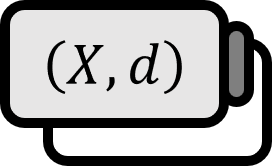Connected Sets in Metric Spaces
Definition
If two subsets $A$ and $B$ of a metric space $X$ satisfy
$$ A \cap \overline{B}= \varnothing \quad \text{and} \quad \overline{A}\cap B= \varnothing $$
then $A$ and $B$ are said to be separated. In other words, there is no point of $A$ included in the closure of $B$, and there is no point of $B$ included in the closure of $A$. A subset $E \subset X$ that cannot be represented as the union of two non-empty separated sets is said to be connected.
Reflecting on the definition above, we see that the concept of being “connected” was created to express a set that is “clearly represented as the union of overlapping sets.”
Theorem
For $E \subset \mathbb{R}$, the following two propositions are equivalent.
(a) $E$ is a connected set.
(b) If $x ,y\in E$ and $x<z<y$, then $z \in E$.
Proof
(a) $\Longrightarrow$ (b)
The proof is by contrapositive. That is, if $z\notin E$, it will be shown that $E$ is a disconnected set. Assume $z\notin E$. Let’s say two subsets $A_{z}$ and $B_{z}$ as follows:
$$ A_{z}=E\cap (-\infty,z),\quad B_{z}=E\cap(z,\infty) \tag{1} $$
Then
$$ E=A_{z}\cup B_{z} $$
holds. Also, because of $(1)$, $x\in A_{z}$ and $y \in B_{z}$, so both sets are non-empty. Similarly, because of $(1)$ $$ A_{z}\cap \overline{B_{z}}=\varnothing,\quad \overline{A_{z}}\cap B_{z}=\varnothing $$
therefore, $A_{z}$ and $B_{z}$ are separated. Since $E$ can be represented as the union of two non-empty separated sets, by the definition, $E$ is a disconnected set.
(a) $\Longleftarrow$ (b)
Similarly, the proof is by contrapositive. That is, if $E$ is disconnected, then $z\notin E$. Assume $E$ is disconnected. Then, by the definition, there are two non-empty separated sets $A$ and $B$ that satisfy $E=A \cup B$. As $A$ and $B$ are non-empty, any $x\in A$ and $y\in B$ can be selected. Without loss of generality, let’s say $x<y$. And, let’s say $z$ as follows:
$$ z =\sup (A\cap [x,y]) $$
Then, by the properties of closure1, the following holds:
$$ z \in \overline{A\cap [x,y]} \subset \overline{A} $$
Since by assumption $A$ and $B$ are separated, therefore $z \notin B$. Now, let’s consider two cases:
case 1. $z \notin A$
Given $z \notin A$, $z \notin B$, and $E=A \cup B$, then $z\notin E$.
case 2. $z\in A$
Since by assumption $A$ and $B$ are separated, therefore $z \notin \overline{B}$. Hence, following the proof process, placing $x$ as $z$ gives:
$$ z<z_{1}<y,\quad z_{1}\notin B $$
There exists $z_{1}$ that satisfies this, and it also satisfies $x<z_{1}<y$ and $z_{1}\notin E$.
■
See Theorem 2 (2a), Theorem 4 ↩︎
